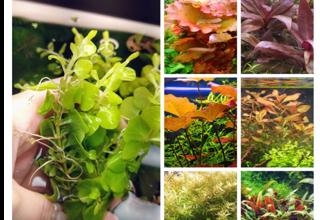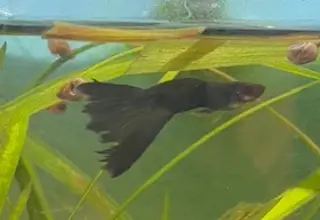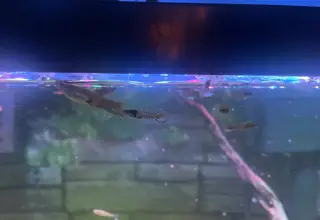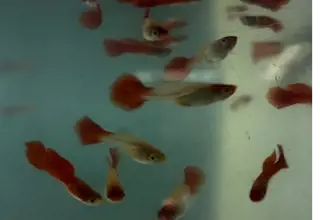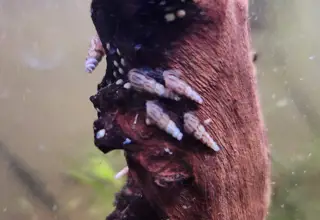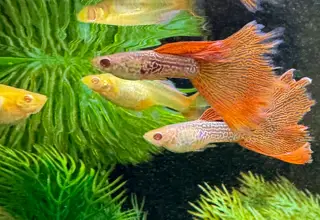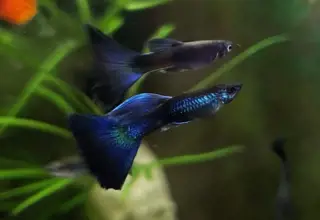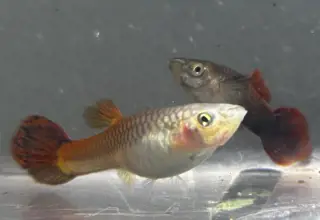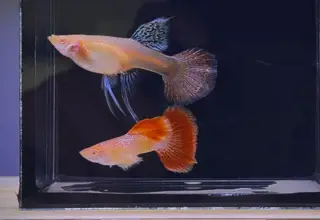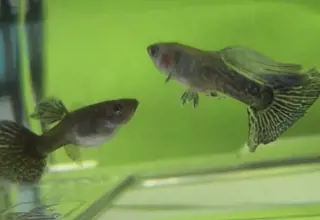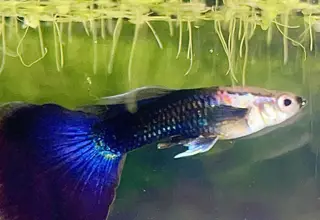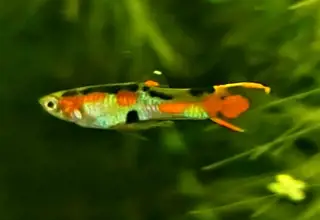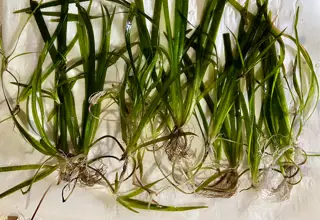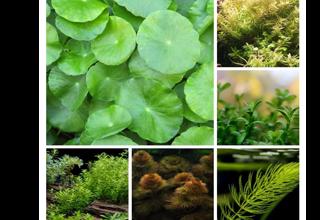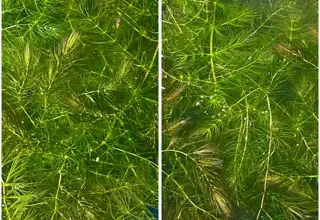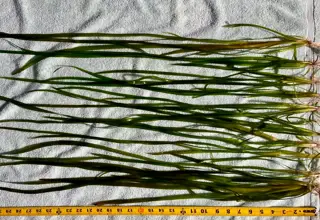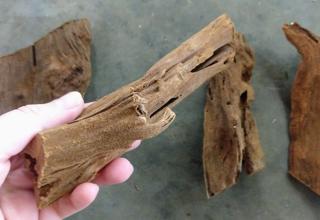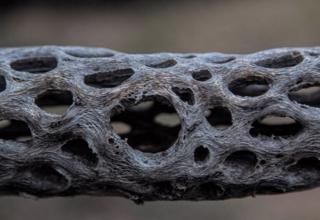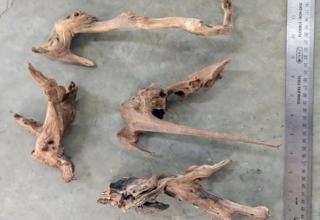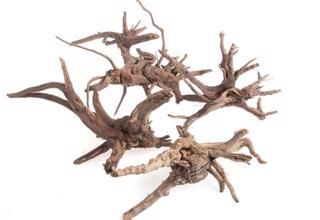Green Dragon Bristlenose Pleco: Care, Size, Lifespan & More
Posted by on 01/24/2023
We use affiliate links and may receive a small commission on purchases.
Plecos are some of the most unique-looking fish in the freshwater aquarium hobby. These catfish have been captivating the minds of hobbyists since their discovery, and their patterns make them some of the most sought-after fish in the freshwater world.
The Green Dragon Bristlenose is an uncommon pleco and can be found in both shortfin and longfin variations. If you're fortunate enough to track down one of these plecos for sale, you'll want to be well-versed in its care requirements. In this post, we're going to cover everything you need to know about this exciting species.
Table of Contents
Species Summary
The Green Dragon Bristlenose Pleco is a member of the Ancistrus genus. These nocturnal catfish are more commonly referred to as bushynose or bristlenose catfish, where the most commonly found fish in the aquarium hobby are descendants from the Ancistrus cirrhosis .
With so many different types of Plecostomus, an L-classification (L being short for the fish's family name: Loricariidae) system was created by the German aquarium magazine DATZ in the 1980s. The classification system is still widely used today, but don't expect to find every pleco species in this classification system. The Green Dragon Bristlenose does not have an L-number, making the species a bit more difficult to locate.
While this species in particular is line-bred, relatives of the fish can be found in Panama, the islands of Trinidad and Tobago, and further south in the rivers and floodplains of the Amazon basin.
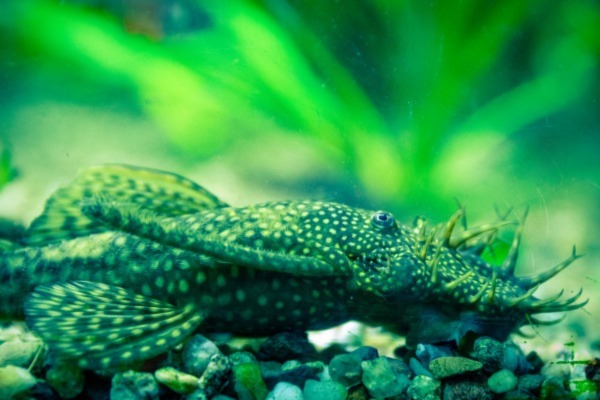
Appearance
One of the most prominent features of a Green Dragon Bristlenose Pleco, or any Bristlenose Pleco, is the unique growth that's present on the nose of the fish. The growth is more pronounced in male fish, but its origins are somewhat shrouded in mystery. It's believed that the growth is tied to reproduction, and it's a commonly discussed topic .
Green Dragon Bristlenose Plecos are covered in gray and black spots that are outlined in an olive coloration. There are two popular variants seen in the hobby, a Longfin version, and a Shortfin version.
Shortfin Green Dragon Bristlenose Pleco
The Shortfin Green Dragon Bristlenose Pleco tends to be the more common of the two species. The fish's dorsal, tail, and pelvic fins are similar in size to other Plecostomus species, such as the Queen Arabesque Pleco.
Each of the fins showcases a translucent gray and green coloration.
🛒 Shop Freshwater Fish on Light Fish
Longfin Green Dragon Bristlenose Pleco
The Longfin Green Dragon Bristlenose Pleco is a more recently developed strain and is greener in color compared to the related Shortfin. It's rumored that the fish was selectively bred by Greg Sage, owner of Select Aquatics .
These fish have long-flowing pectoral, caudal, dorsal, and pelvic fins, making them highly sought after by hobbyists looking to get their hands on one of the most unique-looking plecos in the hobby.
Size
Both longfin and shortfin green dragon bristlenose plecos will grow to reach about 6 inches in length.
These plecos should reach their adult size around the 2-year mark, about a year after they've reached sexual maturity.
Green Dragon Bristlenose Pleco Care
Caring for a Green Dragon Bristlenose Pleco is straightforward. These fish are undemanding when it comes to their care, but it's still your responsibility as an aquarist to provide the best conditions possible so that your fish can thrive.
Even though the longfin variant of this fish is the result of selective breeding, we can look to this fish's relatives to re-create its natural environment.
Lifespan
Both shortfin and longfin green dragon bristlenose plecos are long-lived species. Similar to other Plecostomus species, these fish can live for up to 12 years in captivity.
Providing an optimal environment and a nutrient-rich diet is key to helping your green dragon reach its full potential.
Tank Size
You'll want to have an aquarium that's at least 30 gallons in size if you plan on owning a Green Dragon Bristlenose Pleco.
Green Dragons, similar to other Pleco species, are big eaters, and you should take this into account when it comes to tank size, as a high rate of food consumption results in more waste, and potential ammonia spikes.
Water Conditions
Relatives of the Green Dragon Bristlenose Pleco hail from tropical climates, where they live in fast-moving, pH-neutral, warm waters.
Aim for the following if you plan on housing either a shortfin or longfin Green Dragon Bristlenose Pleco.
Overall, you’ll want to aim for the following water conditions to give you the best chance at success with these fish:
Temperature Range: 73°F-82°F
pH: 6.5-7.6
KH: 3-10 dKH
Make sure that your aquarium is fully cycled before adding any Pleco species. You'll also want to have a testing kit ready to go so that you can monitor pH, ammonia, nitrite, and nitrate. API's Freshwater Master Test Kit should get the job done for the majority of hobbyists.
🛒 Shop Aquarium Plants Fish on Light Fish
Tank Setup
While it may seem intimidating to recreate the natural environment of these fish's relatives in a home aquarium, it can be done! You'll just need to purchase the right equipment and plan accordingly.
Creating an aquascape that uses live plants is a smart decision when housing plecos. Since these fish produce a lot of waste, live plants can absorb some of the harmful compounds produced by fish waste, creating a much cleaner environment for your Green Dragons. Fast-growing species, such as Guppy Grass and Hornwort will be extremely helpful in keeping your tank water as clean as possible.
Plecos can do well with most aquatic plants, but since these fish are a bit larger compared to nano fish, like the blue emperor tetra, you'll want to go for plants that are a bit more durable. Anubias Frazeri, Taiwan Lilies and Hygro are a few excellent options.
Gravel-based substrates such as Fluval's Stratum or Bio-Stratum are great options for pleco owners, and both of these types of gravel will provide extra nutrients for any aquatic plant species you choose to add.
Rocks such as Seiryu stones can be combined to create unique aquascapes, and will most likely remain algae-free thanks to the Green Dragon's algae-eating abilities.
Bristlenose Plecos will consume wood as part of their diet. Small pieces of wood aid in the fish's diet and digestion, so we recommend adding some type of driftwood, such as Mopani or cholla wood. The quantity of wood consumed often varies between individual bristlenose plecos.
A reliable aquarium heater is a must when keeping these fish, as they come from a warm water environment. We also recommend an adjustable powerhead so that you add a sufficient amount of flow.
Plecos aren't known to jump, so a lid isn't a requirement, but it's always a good idea to have one in case you plan on adding additional tank inhabitants.
Common Diseases
Green Dragon Bristlenose Plecos are susceptible to the majority of diseases and infections that affect most freshwater fish.
Be on the lookout for the following diseases which tend to be a bit more common.
Fin Rot
If you've kept other long-finned species, such as Betta fish, then you've probably already heard of fin rot. Unfortunately, both the longfin and shortfin versions of the Green Dragon Bristlenose Pleco are susceptible to this disease, and you must keep your water as clean as possible to prevent this disease from taking hold.
Unfortunately, damaged fins may never heal, but there are steps you can take to stop this bacterial infection from causing more damage. Test your water to determine whether or not you have detectable levels of Nitrite and Nitrate. Assuming your tank is fully cycled, perform 10-20% water changes every hour, over 8 hours until both readings return 0 ppm.
After you've performed the water changes, continue to feed your fish a nutrient-rich diet and your fish should recover quickly!
Ich
If you notice small white dots appearing over your Green Dragon Bristlenose, then more than likely they're suffering from Ich, a disease also known as White Spot Disease. Fish experiencing this disease tend to be lethargic, and you'll need to move your fish to an established quarantine tank to begin treatment with a product like API Super Ick Cure . While it can be frustrating to deal with this disease, your fish can make a full recovery.
Food & Diet
Green Dragon Bristlenose Plecos should be fed nutrient-rich sinking foods, such as shrimp pellets and algae wafers at least 2-3 times a day.
You can supplement their diet with slices of blanched zucchini. The amount of zucchini will largely depend on the size of the tank and the number of plecos you plan on keeping, but a good rule of thumb is half a slice of blanched zucchini per pleco.
Behavior and Temperament
Green Dragon Bristlenose Plecos are peaceful, bottom-dwelling fish. Plecos that have been introduced into an aquarium at the same time can co-exist, but you'll want to avoid adding any additional plecos once your existing plecos have been established. New additions can easily result in territorial disputes.
These fish typically spend their time resting on the substrate or eating algae from driftwood and rocks. They can be territorial when it comes to their food but generally have peaceful personalities.
Tank Mates
When setting up a new aquarium, it is possible to introduce multiple Pleco species such as the Queen Arabesque Pleco along with the Green Dragon Bristlenose. If you're looking to add other types of fish, almost any peaceful schooling fish will do.
Some of our favorites include:
Avoid aggressive fish, such as the Red Dragon Flowerhorn Cichlid or Electric Blue Jack Dempsey.
Breeding
Breeding the Green Dragon Bristlenose Pleco in captivity is possible. If you're interested in breeding the species, you'll want to follow these steps:
- Set up a breeder tank and add gravel, as well as a filtration system to maintain water quality. Wait for the tank to fully cycle.
- Create artificial caves, preferably ones that look natural, to provide the fish with a sense of security during breeding.
- Raise the temperature of the tank to 77-78°F.
- Introduce a sexually mature male into the breeding tank and add a female. Observe their interaction, if the male is excessively chasing the female, move the male back to the display tank and try again after a few days.
- When a pair is formed, the fish will typically hang inside or around the artificial caves before mating. Spawning can take between a few minutes and a few days.
- The female will lay hundreds of orange eggs and the male will guard them until they hatch, usually 3-5 days later.
- Raise the fry. This is the most challenging step. Some hobbyists prefer to transfer the fry to a nursing tank, while others raise them in the breeding tank. Feed them powdered spirulina or infusoria for the first 3-4 days, then transition to bits of baby brine shrimp and crushed-up flake food.
The most important part of raising the fry is maintaining optimal water quality. You'll want to perform 25% water changes every other day. After 1-2 months have passed, your fry will be considered juveniles, and you'll have successfully bred Green Dragon Bristlenose Plecos.
In Conclusion
As you can see, the Green Dragon Bristlenose Pleco is a fish that has a lot to offer. With two different fin variations, hobbyists can choose which variant they prefer when building out their dream aquarium.
While this species in particular can be difficult to obtain, tracking one down is well worth it (you may even discover one for sale on our marketplace!) If you own or plan on caring for this species, we'd love to hear from you. Drop a comment below, and be sure to check out our community forum where we discuss everything related to the freshwater and saltwater aquarium hobby.
December's Giveaways on Light Fish
